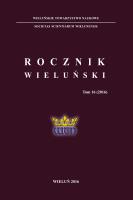Obciążenia feudalne chłopów w majątku Rudniki w XIX wieku w świetle inwentarza dóbr z roku 1830, tabel prestacyjnych i likwidacyjnych
Feudal obligations of peasants in Rudniki estate in the 19th century in the light of the estate inventory from 1830, service and liquidation tables
Author(s): Alicja KisałaSubject(s): Modern Age, 19th Century
Published by: Wieluńskie Towarzystwo Naukowe
Keywords: XIX century;Poland;feudal obligations;land ownership structure;the Rudniki estate;
Summary/Abstract: The article describes the financial situation of peasants who lived on the Rudniki estate in the first half of the nineteenth century. In the early days of the Kingdom of Poland the nobility owned 3⁄4 of all the villages and farms across the country. The peasant farm size reduction in order to expand noble farms resulted in a deterioration of the economic situation of the peasants and a growing number of landless farmers. Although the Constitution of the Duchy of Warsaw provided personal freedom and equality before the law, the nobility still owned most of the land. At the beginning of the nineteenth century the Rudniki estate in the Wieluń County belonged to the Masłowski Family. An inventory report written in 1830 describes that their property con-sisted of Rudniki, Kuźnica, Młyny and Jawor villages, Buciny and Dalachów colonies as wellas Faustyanka and Błonie noble farms. Besides serfdom, peasants were obliged to pay tributein kind depending on their farm sizes. A few years later these goods passed into the hands ofHenryk Miączyński of Suchekomnaty coat of arms brougth as a dowry by Masłowska. TheTsar’s decree issued on 26 V (7 VI) 1846 partially improved peasants’ financial status. So called“Prestation tables”, compiled by the owners of private estates, provide us with valuable, detailedinformation about economic conditions of peasants. The prestation tables of Rudniki estate en-compass the list of peasants’ names, size of individual farms, amounts of cereals sown, infor-mation about buildings, obligations towards estate owner, the church, the rural community, thegovernment, the insurance company as well as additional income sources. Although the entriesmade in prestation tables should not be accepted uncritically, they are reliable historical sourcesas they provide basic data on the land ownership structure and the villagers’ relationship with thedominion in a unified form.
Journal: Rocznik Wieluński
- Issue Year: 16/2016
- Issue No: 16
- Page Range: 162-173
- Page Count: 12
- Language: Polish

